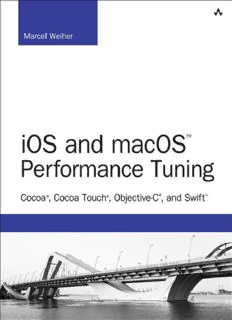Table Of ContentAbout This E-Book
EPUB is an open, industry-standard format for e-books. However, support for
EPUB and its many features varies across reading devices and applications. Use
your device or app settings to customize the presentation to your liking. Settings
that you can customize often include font, font size, single or double column,
landscape or portrait mode, and figures that you can click or tap to enlarge. For
additional information about the settings and features on your reading device or
app, visit the device manufacturer’s Web site.
Many titles include programming code or configuration examples. To
optimize the presentation of these elements, view the e-book in single-column,
landscape mode and adjust the font size to the smallest setting. In addition to
presenting code and configurations in the reflowable text format, we have
included images of the code that mimic the presentation found in the print book;
therefore, where the reflowable format may compromise the presentation of the
code listing, you will see a “Click here to view code image” link. Click the link
to view the print-fidelity code image. To return to the previous page viewed,
click the Back button on your device or app.
iOS and macOS™ Performance
Tuning
® ® ®
Cocoa , Cocoa Touch , Objective-C , and Swift™
Marcel Weiher
Boston • Columbus • Indianapolis • New York • San Francisco • Amsterdam •
Cape Town
Dubai • London • Madrid • Milan • Munich • Paris • Montreal • Toronto • Delhi •
Mexico City
São Paulo • Sydney • Hong Kong • Seoul • Singapore • Taipei • Tokyo
Many of the designations used by manufacturers and sellers to distinguish their
products are claimed as trademarks. Where those designations appear in this
book, and the publisher was aware of a trademark claim, the designations have
been printed with initial capital letters or in all capitals.
The author and publisher have taken care in the preparation of this book, but
make no expressed or implied warranty of any kind and assume no responsibility
for errors or omissions. No liability is assumed for incidental or consequential
damages in connection with or arising out of the use of the information or
programs contained herein.
For information about buying this title in bulk quantities, or for special sales
opportunities (which may include electronic versions; custom cover designs; and
content particular to your business, training goals, marketing focus, or branding
interests), please contact our corporate sales department at
[email protected] or (800) 382-3419.
For government sales inquiries, please contact
[email protected]. For questions about sales outside the U.S.,
please contact [email protected]. Visit us on the Web: informit.com/aw
Library of Congress Number: 2016961010
Copyright © 2017 Pearson Education, Inc.
All rights reserved. Printed in the United States of America. This publication is
protected by copyright, and permission must be obtained from the publisher
prior to any prohibited reproduction, storage in a retrieval system, or
transmission in any form or by any means, electronic, mechanical,
photocopying, recording, or likewise. For information regarding permissions,
request forms and the appropriate contacts within the Pearson Education Global
Rights & Permissions Department, please visit
www.pearsoned.com/permissions/.
ISBN-13: 978-0-321-84284-8
ISBN-10: 0-321-84284-7
1 17
Editor-in-Chief
Greg Wiegand
Senior Acquisitions Editor
Trina MacDonald
Development Editor
Songlin Qiu
Managing Editor
Sandra Schroeder
Full-Service Production
Manager
Julie B. Nahil
Project Manager
Melissa Panagos
Copy Editor
Stephanie Geels
Indexer
Jack Lewis
Proofreader
Melissa Panagos
Technical Reviewers
Christian Brunschen
BJ Miller
Christian Neuss
Dominik Wagner
Editorial Assistant
Olivia Basegio
Cover Designer
Chuti Prasertsith
Compositor
Lori Hughes
Contents at a Glance
Contents
About the Author
Introduction
1 CPU: Principles
2 CPU: Measurement and Tools
3 CPU: Pitfalls and Techniques
4 CPU Example: XML Parsing
5 Memory: Principles
6 Memory: Measurement and Tools
7 Memory: Pitfalls and Techniques
8 Memory Example: FilterStreams
9 Swift
10 I/O: Principles
11 I/O: Measurement and Tools
12 I/O: Pitfalls and Techniques
13 I/O: Examples
14 Graphics and UI: Principles
15 Graphics and UI: Measurement and Tools
16 Graphics and UI: Pitfalls and Techniques
17 Graphics and UI: Examples
Index
Contents
About the Author
Introduction
1 CPU: Principles
A Simple Example
The Perils of (Micro-)Benchmarking
More Integer Summing
Swift
Other Languages
The Power of Hybrids
Trends
Cost of Operations
Computational Complexity
Summary
2 CPU: Measurement and Tools
Command-Line Tools
top
time
sample
Xcode Gauges
Instruments
Setup and Data Gathering
Profiling Options
Basic Analysis
Source Code
Data Mining I: Focus
Data Mining II: Pruning
Internal Measurement
Testing
Dtrace
Optimization Beyond the Call of Duty
Summary
3 CPU: Pitfalls and Techniques
Representation
Primitive Types
Strings
Objects
Accessors
Public Access
Object Creation and Caching
Mutability and Caching
Lazy Evaluation
Caching Caveats
Pitfall: Generic (Intermediate) Representations
Arrays and Bulk Processing
Dictionaries
Messaging
IMP Caching
Forwarding
Uniformity and Optimization
Methods
Pitfall: CoreFoundation
Multicore
Threads
Work Queues
Mature Optimization
4 CPU Example: XML Parsing
An HTML Scanner
Mapping Callbacks to Messages
Objects
Objects, Cheaply
Evaluation
Tune-Ups
Optimizing the Whole Widget: MAX
MAX Implementation
Summary
5 Memory: Principles
The Memory Hierarchy
Mach Virtual Memory
Heap and Stack
Stack Allocation
Heap Allocation with malloc()
Resource Management
Garbage Collection
Foundation Object Ownership
Tracing GC
Automatic Reference Counting
Process-Level Resource Reclamation
Summary
6 Memory: Measurement and Tools
Xcode Gauges
Command-Line Tools
top
heap
leaks and malloc_debug
Internal Measurement
Memory Instruments
Leaks Instrument
Allocations
VM Tracker
Counters/PM Events
Summary
7 Memory: Pitfalls and Techniques
Reference Counting
Avoiding Leaks
Foundation Objects vs. Primitives
Smaller Structures
But What About Y2K?
Compression
Purgeable Memory
Memory and Concurrency
Architectural Considerations
Temporary Allocations and Object Caching
NSCache and libcache
Memory-Mapped Files
madvise
iOS Considerations
Optimizing ARC
Summary
8 Memory Example: FilterStreams
Unix Pipes and Filters
Object-Oriented Filters
DescriptionStream
Eliminating the Infinite Recursion from description
Stream Hierarchy
Summary
9 Swift
Swift Performance: Claims
Language Characteristics
Description:In iOS and macOS™ Performance Tuning, Marcel Weiher drills down to the code level to help you systematically optimize CPU, memory, I/O, graphics, and program responsiveness in any Objective-C, Cocoa, or CocoaTouch program. This guide focuses entirely on performance optimization for macOS and iO

